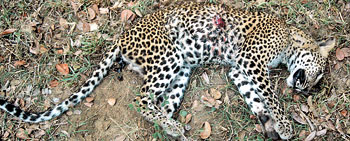The carcass of a young leopard was found near Patanangala on October 22, around 6.a.m. by a group of wildlife enthusiasts who had set out early to get a glimpse of the morning wildlife.
The body had not been touched by predators and was still warm at the time it was found with a wound visible on its side, raising suspicion that it could have been killed by a wild boar attack.
However, the carcass was sent to Udawalawe for a post-mortem and it was revealed that the leopard in fact had been killed by a speeding vehicle inside the park.
The veterinary team that conducted the post-mortem found that the leopard’s ribs were smashed and its lungs damaged. Dr.Vijitha Perera who headed the team said that kind of injury could only be caused due to a collision with a speeding vehicle.
Leopards are the key attraction at Yala and sometimes it is overcrowded by tourists who visit the park mainly to get a glimpse of the elusive big cat. The tourists often spend long hours in the park to maximize the opportunity of leapord sightings. However, since there is a rule that vehicles should leave the park at 6.30 p.m., some vehicles make a last minute dash speeding towards the exit just in time. Wildlife officials believe that one such vehicle could have been the culprit behind this hit and run tragedy.
 |
But the fact that the leopard was found in the morning with its body still warm and untouched by predators such as mongoose and not even covered by ants, has many wildlife activists believe that the fatal accident would have happened just a couple of hours before it was discovered in the morning. “If it happened in the morning it won’t be difficult to trace those responsible as only a few vehicles are usually found in the park that early,” Rukshan Jayawardene of the Leopard Trust said.
Pointing out that the leopard was a young female around six months old, Mr. Jayawardene said losing a female in Yala endangered the species more than when losing a male. A male leopard mates with several females so the death of a female means losing about several cubs for Yala.
He said the Department of Wildlife Conservation (DWC) should launch an investigation to find the culprits and to impose strict regulations about speed limits to curb such tragedies in the future.
It is well known that over-visitation is a huge problem at the Yala Park, especially since the end of the war. On some long weekends, there are over 150 vehicles driving visitors into the park. However due to the limited number of trained wildlife trackers it is difficult to assign a tracker for every jeep thus leaving room for reckless behaviour by visitors, wildlife activists point out.
Most of the visitors’ main aim is to see as many wildlife as possible and sometimes at their insistence the trackers are forced to comply resulting in speeding vehicles and traffic jams.
The increase in the number of enthusiasts whose main hobby is to click a leopard has also aggravated the situation. This hobby has its downside especially with the popularity of Facebook where photographs are shared encouraging others to take their own leopard shots. This has has already driven away genuine wildlife photographers. “We no longer visit Yala,” said wildlife photographer Namal Kamalgoda who was a fan of Yala about a decade ago. He said many wildlife lovers like him have stopped visiting Yala and are looking at other prospects.
Yala is also being promoted as a tourist destination by the Tourism Promotion Bureau. But wildlife lovers say that even foreign tourists would stop going to Yala if there isn’t a check on the unruly behaviour, mainly of local tourists.
Wildlife biologist Manori Gunawardane says the tourism industry should impose self regulation to control the situation in national parks like Yala. Simple measures such as not to employ a jeep driver who misbehaves too can make an impact say conservationists.
She said many jeep drivers and tour operators have not understood the real meaning of a wildlife experience and believe that it only boils down to taking a photograph of one wildlife sighting and then rushing to another. She also said targeting some parks as safari sites for one species or another has also endangered the tranquility of these nature reserves.
Commenting on over-visitation, DWC Director General H.D.Ratnayake said that they are opening other wildlife spots to ease the pressure on the popular sites. He said measures have been taken to strengthen the existing rules regarding speeding vehicles with moves to cancel the licences of those who do not adhere to the speed limits. He also said investigations are being carried out on the death of the leopard. |


